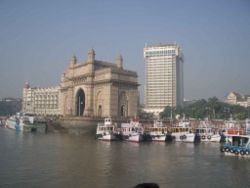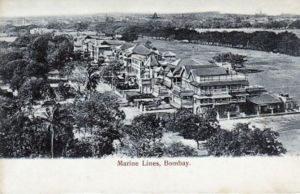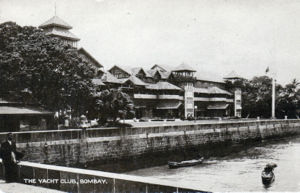Bombay (City)
| Bombay (City) | |
|---|---|

| |
| Presidency: Bombay | |
| Coordinates: | 19.017656°N, 72.85618°E |
| Altitude: | 8 m (26 ft) |
| Present Day Details | |
| Place Name: | Mumbai |
| State/Province: | Maharashtra |
| Country: | India |
| Transport links | |
| Bombay, Baroda and Central India Railway Great Indian Peninsula Railway Bombay Port Trust Railway | |
Bombay (now Mumbai) was the capital of the Bombay Presidency and is now the capital of the state of Maharashtra.
Contents
History
The city was Portuguese controlled from 1534 and under British rule from 1661 when it was received by Charles II as part of his marriage dowry from his Portuguese wife, Catherine De Braganza. In 1668 it was granted to the East India Company for a lease of ten pounds a year. Until the 18th century, Bombay consisted of seven islands. The islands were merged to form the present day location of the city.
Compared to the other Presidencies, Bombay was of minor significance before 1800. The English were very much the minority. Recognising this, a liberal attitude encouraged progressive Indian cotton merchants, this freedom resulted in Bombay's economic importance. It was the cotton industry that spurred economic migration to the city from surrounding rural areas, and saw Bombay’s population grow rapidly:
- Year Population
- 1700 10,000
- 1800 100,000
- 1900 775 000
Following the Battle of Kirkee 1817 and the defeat of the Peshwas, the Bhor Ghat road to Poona opened 1830, allowing greater access to the Deccan cotton fields. Railways much improved goods transport, the Great Indian Peninsula Railway (GIPR)opened in 1864 which allowed Bombay to exploit the demand for cotton resulting from the American Civil War’s blockade of its southern ports(1860-1865). The opening of the Suez Canal 1869 further improved the export trade to England. The resultant economic boom saw wealthy businessmen sponsor many civic buildings – University Library Buildings, Jamseti Jijibhoy School of Art, and the Mechanics institute. From the 1860‘s many municipal improvement schemes focused on improving health and sanitation.
Because of the cosmopolitan mix of Bombay Society, it is architecturally unlike the most of colonial india's neo-classicism; the wealth citizens of Bombay, and the city's Public Works Department opted for Venetian-Gothic designs with alterations to suit the Indian Climate. Victoria Terminus the station of the GIPR, adorned with Indian motifs represents this patronage.
Churches
Anglican
- All Saints - Malabar Hill
- Christ Church - Byculla
- St. Thomas Cathedral - the oldest Anglican church in the city, built in 1718, consecrated 1816, became the cathedral of the See of Bombay in 1833. On the south side of Church Gate Street. Originally the garrison church. See Bombay Church by Richard Cobbe for an account of the building of the English Church.
Presbyterian
- St Andrew's - the Scotch Kirk, Rampart Row, opened 1819
- St John the Evangelist, Colaba - aka the Afghan Church, consecrated 1858. Built to commemorate the dead of the 1st Afghan War.
Roman Catholic
Addresses of all current Catholic Churches in Mumbai (Archdiocese of Mumbai). See also Bombay in the Catholic Encyclopedia 1913.
- Cathedral of the Holy Name
- Church of the Holy Trinity
- Gloria Church - aka Nossa Senhora de Gloria, founded 1632, at Byculla
- Mount Mary Church, Bandra - aka the Basilica of Our Lady of the Mount
- Our Lady of Egypt - founded 1606
- Our Lady of Good Counsel - aka Nossa Senhora de Bom Concelho, founded 1596
- Our Lady of Health - aka Nossa Senhora de Saude, built 1794
- Our Lady of Hope - aka Nossa Senhora da Esperanca, demolished
- Our Lady of Salvation - aka Nossa Senhora de Salvação or the Portuguese Church, founded 1596, current structure is 1974
- St. Andrew's Church - built 1575
- St Michaels - founded by the Portuguese in 1534 (current building dates only to 1973)
- St Peter's, Bandra - Jesuit church. Original building 1852, current building 1938, consecrated 1964
Other
- Free Church of Scotland
- Wesleyan Methodist Church - at Colaba
- St Nicholas
- Synagogue Megan David, Byculla 1961
- Synagogue Kneseth Elijah, The Fort 1888
Cemeteries
- European Burial Ground, Queens Road
- Mavgav, Byculla, the oldest cemetery (Bene-Israel)
Schools
The English established the Bombay Education Society 1815 with the primary object of educating European and Anglo-Indian children. But from the very beginning the society admitted Indian children to its schools without making religious education compulsory. In 1818 the society started English schools in Bombay city. In 1820 it established a separate committee, the Bombay Native Education Society to look after the education of Indian children
- Fort Proprietary School was opened in 1859.
- Scottish Schools (Byculla),
- Scottish Schools (Fort),
- Cathedral Choir School (Fort)
- Cathedral High Scool
- Alexandra Girls School
- Islamia School
Catholic
Boys
- The High School of St. Xavier
- St. Mary's High School
Girls
- Girls High Schools, at Clare road, Par el and the Fort.
- St. Joseph's Foundling Home
- St. Vincent's Home for poor women and girl
Orphan Schools
Refer Orphans-Bombay
Tertiary Education
- Elphinstone College 1835
- Grant Medical Institution 1845
- Bombay Law School
- The Government Law College, 1855
- Wilson College
- St Xavier’s College (Catholic)
- The Sydenham College
- Jamseti Jijibhoy School of Art
- Victoria Jubilee Technical Institute
Hospitals
- European General Hospital
- Cama Hospital opened on the Esplanade in August 1886
- Bomanji Edulji Albless Obstetric Hospital in 1890
- St. George's Hospital Government (for Europeans) in December 1892
- The Gokuldas Tejpal Hospital 1868
- Acworth Leprosy Hospital , Wadala was established in 1890
- National Medical College on 4 September 1921
- Nowrosjee Wadia Maternity Hospital in 1927
- Bai Jerbai Wadia Hospital for Children in 1929
- Seth Gordhandas Sunderdas Medical College was started in June 1925,
- King Edward Memorial Hospital in February 1926
- The Nair Hospital Dental College
- The Ismail Yusuf College, established in 1929-30
Newspapers
- Bombay Chronicle, 1918-1933
- Times of India, 1873-1942
- Bombay Gazette,
- Advocate of India (Anglo-Indian)
Military
- HQ of Bombay Brigade in Poona Division of the Western Command
- Garrison
- 3 companies of artillery,
- 2 Native infantry,
- 5 corps volunteers: Bombay Light Horse, Bombay Volunteer Artillery, GIPR Volunteers, B,B & CIR Volunteers, Bombay Volunteer Rifles,
- Royal Indian Marines
Clubs
- The Catholic Gymkhana Club, Marine Lines
- Byculla Club, Byculla
- Yacht Club, Wellington Pier
- Bombay Club,Esplanade
External links
Historical Books Online
- An Historical Account of the Settlement and Possession of Bombay, by the English East India Company, and of the Rise and Progress of the War with the Mahratta Nation by Samuel Pechel (1781) Google Books
- Bombay 1809 Journal of a Residence in India by Maria Graham, 2nd Edition (1813) Illustrated by Engravings, Google Books
- The English in Western India: being the early history of the factory at Surat, of Bombay, and the subordinate factories on the western coast by Philip Anderson (1854) Google Books
- A Handbook for India. Part II. Bombay London: John Murray (1859) Google Books
- Bombay place-names and street-names; an excursion into the by-ways of the history of Bombay City by Samuel Townsend Sheppard (1917) Archive.org
- Gazetteer of the Bombay Presidency:
- Volume 26, Part 1 Materials towards a statistical account of the Town and Island of Bombay - History 1893 Archive.org
- Volume 26, Part 2 Materials towards a statistical account of the Town and Island of Bombay - Trade and Fortifications 1894 Archive.org
- Volume 26, Part 3 Materials towards a statistical account of the Town and Island of Bombay - Administration 1894 Archive.org
- Glimpses of old Bombay and western India, with other papers by James Douglas 1900 Archive.org
- The Times of India Directory. The following volumes are available to read online on the Digital Library of India website.
- The Times of India Calendar and Directory for 1907. Contains information for India generally. Contents, computer page 51
- The Times of India Directory of Bombay (City and Presidency) Karachi-Poona- Ahmedabad etc. 1932. Index, computer page 42
- The Times of India Directory of Bombay (City and Presidency) Karachi-Poona- Ahmedabad etc. 1935. Index, computer page 26
- The Times of India Directory of Bombay (City and Provincial) including Karachi and Hyderabad State 1939. Index, computer page 13
Other
- Maharashtra State Gazette 1986A modern gazette of Bombay with a comprehensive history of the city taken from many historic records and books. Detailed yet very readible and covers many subjects.
- Bombay City Love to Know 1911.
- Mumbai Wikipedia.
- History of MumbaiA brief yet informative history covering key people and events during European settlement and post Indepenence
- History of Mumbai Wikipedia.
- Bombay Map 1909 from the Asia Historical Maps Collection, University of Texas, Austin
- “Narcotics and empire” from Frontline-The Hindu. A review of the book Opium City, The Making of Early Victorian Bombay by Amar Farooqui
- World War II Operational Documents: Port summary of Bombay, India. 1945 from Combined Arms Research Library Digital Library
- Watson's Hotel, Mumbai Photographs from Skyscrapercity.com
- Lieutenant Lachlan Macquarie arrived in India in August 1788 with the 77th Regiment of Foot. His Journal describes his life in Bombay. From Macquarie University’s Lachlan and Elizabeth Macquarie Archive
- Eight Views of Bombay by James Wales (1791-1795) from Macquarie University’s Lachlan and Elizabeth Macquarie Archive

